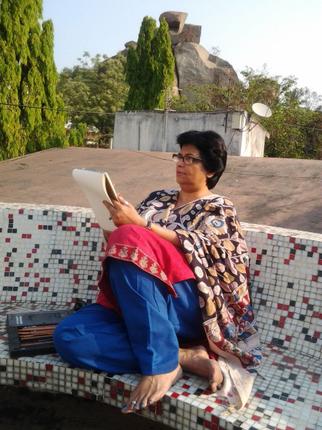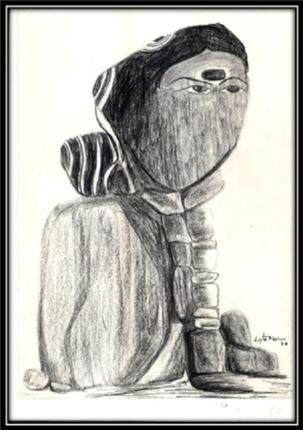
The balance of the rocks has always fascinated Lata Marur who’s specialised in ‘rock art’
‘Nalla’ is black and ‘konda’ is hill in Telugu, explains artist Lata Marur about Nalgonda, her home town that is rich with rocks of black granite. She thinks that her connection with the rocks started from there. “Our home there is surrounded by rocky hills with a Dargah on top. Every summer visiting our grandparents there, the first thing to do would be to climb the rocks and write our name on them. Maybe my name is still there!”
She is fascinated by the balancing act that our rock formations are replete with. “The balance looks so precarious that initially you are scared to go close, in case the rock falls! But when you go and touch the rock, you see that it is so strong.” In fact this wonder generating visual has been commonplace in Hyderabad.
“When we were small, for Sankranti Bommalu Koluvu, my mother used to give us siblings different spots to work on. My sister helped mom set the dolls on the steps, my brother would do something with cars, making a path with lights etc. I would do one corner with pebbles and rocks, balancing them and making hill-like formations. When we moved to Hyderabad, I was 11 years old. We were looking for a house in Srinagar Colony which was then full of lovely rock formations. When I saw them balancing I thought someone actually had made the formation balance. Recalling my own rock balancing efforts at Sankranti, I exclaimed in childlike admiration “Who did this?! How did they make these balance?! It was only as I grew up that I learnt of geology and weathering that explained it for me.”

Lata Marur has created a series of rock sketches around the Dashavatara. “Going toward Shamirpet, I saw a rock that looked like Rama: straight, rock-like and peaceful. That is when the Dashavatara rock series began. I saw a horse in one of the rocks on the way to Nalgonda recalling Kalki, the avatar that comes on a horse. There are lots of rocks in the fields on the way to Bangalore and one particular rock has a huge lion-like face. It recalled Narasimhavatara for me. It is inspiring how the farmers have instinctively left the rocks alone and not taken them out to enlarge their fields. The drive is a pleasure because of those rocks and similarly for the Nalgonda rocks.”
Talking of rocks destroyed in the development of the city, one of her favourites used to be on the road in front of Daspalla Hotel. “It was formed like an easy-chair. That whole formation is gone and there is a building there now.” It is in this context that “Rockatantra”, a book with her sketches and accompanying stories by her husband Vijay Marur, brings rocks to life, giving them a voice amidst their own destruction.
She rationalises that “It is not easy to protect all the rocks. You cannot expect civilisation to stop to keep rocks. But when a rock is protected I feel really happy. I am also glad the awareness is higher now about the ecological and aesthetic value of the rocks and people are incorporating rocks into their gardens and homes.”
Clearly there is a balance to be sought in how we respond to our development demands while also preserving an age old contributor to our city’s unique geographic aesthetic and ecological health. An inspiring example of such miraculous seeming balance lies all around us in our rocks.
(The writer is a documentary film maker, writer and teacher.)
source: http://www.thehindu.com / The Hindu / Home> News> Cities> Hyderabad / by Uma Magal / Hyderabad – April 10th, 2014